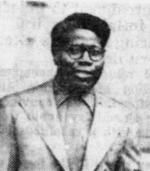 Tampa Bay Times (St. Petersburg, Florida). December 24, 1952. On July 18, 1943, in Petersburg, Virginia, police officers Robert Hatchell and W.M. Jolly were on their regular patrol when a car with out-of-state plates caught their attention. Ordered to pull over, the driver of the car suddenly sped away and, after a high-speed chase, crashed in a dead-end street. The driver, a black man wearing a white cap, jumped out and ran off. While Hatchell chased the fleeing driver, Jolly arrested the two passengers in the wrecked car, who identified themselves as soldiers who had been picked up by the driver when they were hitchhiking near Raleigh, North Carolina, the area from which the car had been stolen. A half hour later, Jolly found Hatchell lying in the grass, unconscious and bleeding from a bullet wound. Hatchell died soon after. A short time later, Silas Rogers, a 21-year-old black shoe shiner from Miami, Florida, was apprehended while thumbing a ride out of town. The soldiers who were in the car at the time of the crash identified Rogers as the killer. A patient who had viewed the incident from the nearby hospital also identified him. Rogers claimed that at the time of the murder, he was on a train headed for New York City where he had an appointment with the draft board. He said he had been “train-hopping” his way to New York City until his illegal passage was discovered by a train employee and he was asked to leave the train. After hours of interrogation, Rogers confessed to the murder of Hatchell. Later, it was determined that this confession was the result of physical torture and, thus, it was not introduced at trial. Within a week, Rogers was indicted and several weeks later the trial began before an all-white jury. Based on the eyewitness identifications, the jury found Rogers guilty of first-degree murder on August 27, 1943, and he was sentenced to death in the electric chair with an execution date of January 21, 1944. After a series of reprieves, his sentence was commuted to life in prison on October 13, 1945. While he was incarcerated, Rogers’s case caught the attention of Erle Stanley Gardner’s Court of Last Resort, known for its interest in reinvestigating cases of inmates claiming innocence. They studied the circumstances of Rogers’s conviction, discovering that none of the fingerprints taken from the stolen car belonged to Rogers. They also located the train employee who corroborated Roberts’s alibi that he was on the train at the time of the murder by verifying that Roberts was “the man I put off the train.” In addition, a newspaperman from the Richmond News Leader discovered that Rogers had no driver’s license and did not even know how to drive a car. On December 23, 1952, after reviewing the new evidence in Rogers’s case, Governor John S. Battle granted Rogers an unconditional pardon and released him from custody. The identity of the actual perpetrator remained a mystery. – Dolores Kennedy
|